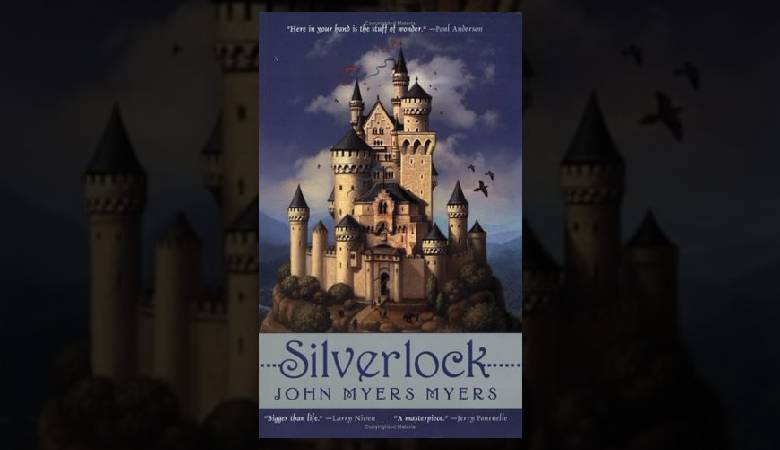Journeys of self-discovery appearing in every genre, teaching us about the main character as well as ourselves. The journey takes many forms: Gilgamesh searching for immortality; Dante’s trips to Heaven, Hell, and Purgatory; and Wyatt and Billy’s road trip in Easy Rider, among many others. These voyages speak to human beings’ desire to answer fundamental questions about their place in the world. John Myers Myers takes a novel approach to this genre in Silverlock. His main character learns about himself by participating in the lives of other literary figures.
A chance event and a preliminary literary allusion start the story in Silverlock. The dreadfully dull A.Clarence Shandon (B.A., Business Administration) is on board the Naglfar (several days out of Baltimore) and threatened by shipwreck. Already, Myers Myers is hinting at the primary component of the book — the Naglfar is the ship that Loki pilots to Ragnorak. After the ship sinks, Shandon is thrown together with the mysterious Boyan Taliesin Golias. Golias saves Shandon’s life and becomes his guide and traveling companion through the strange country known as the Commonwealth. This journey is one of self-discovery for Shandon, with the living literature he meets serving as the catalyst for his development. After Golias rescues Shandon from a life as a pig (compliments of Circe), he and Shandon are thrown together with a Viking raiding party. From that point, the literary and mythical allusions come so fast and thick, it’s almost impossible to keep up. Along the way, Shandon picks up the nickname “Silverlock” due to the shock of white hair at the crown of his head.
Myers inserts a tremendous stream of literary, mythical, and historic characters into Silverlock — Brian Boru, Beowulf, Job, Don Quixote, Puck, the Green Knight, Tam Lin, Robin Hood, Odin, Oedipus, Anna Karenina, Cerberus, Captain Ahab, Prometheus — the list goes on and on. The only list that dwarfs it is the one that accumulates through Golias’ name-dropping. Since he embodies a small community of singers and storytellers in himself (Taliesin and Orpheus are only two of his names), this comes as no surprise. Myers deftly manages the incorporation of mythical characters from many different traditions into a single storyline while keeping the focus on the main character; none of the literary figures really overshadows Shandon.
Shandon starts the book ignorant of all things literary; he is an eminently practical man. His first encounter in the Commonwealth is with Circe, who (following her standard practice) turns him into a pig. Golias arrives just in time to extricate Shandon, beginning his services as guide and explicator of the Commonwealth. As he wanders through the Commonwealth, Shandon gradually opens his mind to possibilities beyond the commonplace. He is making up for lost time; the countryside allows him to absorb literature directly through experience. It’s a subtle process — the Commonwealth slowly seduces Shandon and builds his appreciation for the world of letters.
This slow seduction is crucial to Silverlock’s plot. Shandon is an unwitting and, initially, unwilling participant in his own journey. His motivation grows with each adventure. The subtle allure of great literature is slowly laid out by Myers, who does his best to entrance both Shandon and the reader. The pull of the story transports the reader mentally to where Shandon is physical. Simply put, reading great stories draws us out of ourselves. Reading stories adds new horizons, shows new opportunities and offers us the chance to become better people. And Shandon experiences all of this. Because he is the stereotypical self-absorbed realist, cracking open a book wouldn’t work for him. Shandon has to really live the literature instead. Lucky readers who already have an open gateway to the riches of the Commonwealth can get the same value from a vicarious reading. You don’t have to ride down a river on Huck Finn’s raft as Shandon does for great writing to really sink in.
The encounter with Don Quixote is the crucial moment in Silverlock. This experience forces Shandon to flex mental muscles he’s never used before. It’s a breakthrough — he begins to use his imagination. Where before he was thoroughly grounded in the mundane, repeated exposure to the population of the Commonwealth has changed Shandon. By interacting with Quixote and using his imagination, Shandon shows that he can grow beyond simple physical interests and pleasures. He begins to live literature (and life) rather than cynically observing it. Sending Don Quixote off to battle the “evil giant” Paul Bunyan is only the beginning for Shandon. He also matures through the course of his adventures; by the time he tries to help retrieve Tam Lin from the Faeries, he is beginning to act altruistically rather than basely.
Crowding many different characters from literature and myth together and keeping them linked to their original stories illustrates the Commonwealth’s only drawback. It has to play out like a recording to be truly enjoyed. Golias himself hints at the auto rewind nature of the Commonwealth. When he first meets Shandon, Golias suggests that drowning will just cause him to start over again somewhere else. Otherwise, Shandon’s timing must be impeccable. Everything happens just as (or shortly before) he arrives. This is great fun for the reader, but one wonders how other visitors can enjoy the Commonwealth as much as Shandon. Shandon staggers into the middle of A Midsummer Night’s Dream; he gets to Heorot just in time to celebrate Beowulf’s victory over Grendel; he shows up just as Tam Lin is released. This is Silverlock’s only weakness. Myers weaves most of these incidents into a coherent storyline, but he does overreach himself. For example, Shandon’s meeting with Odin (straight out of the Ring of the Nibelungen) appears as extra ornamentation to a highly gilded story.
What’s the point of visiting Heorot five years after Beowulf was there, or meeting Robin Hood after he’s been pensioned? By translating texts into living characters, Myers duplicates the literature accurately; novels and poems are infinitely patient. Every time you open one, the book is as fresh as it was the first time you read it. Shandon’s ability to interact with each character, drawing things out of them that might not be in the original storyline, is a physical manifestation of the new insights you gain with each reading of a book.
“A man is not dead until he ceases to be curious” (Silverlock, page 80). Shandon starts out dead, no doubt due in a large part to that business administration degree. Only a journey through the Commonwealth of Letters can stir him to life again. Myers Myers does a great service by gently reminding us of all that is great about reading. Silverlock is the perfect refresher to show how even ancient and timeworn stories are always ready to be seen fresh once again.





